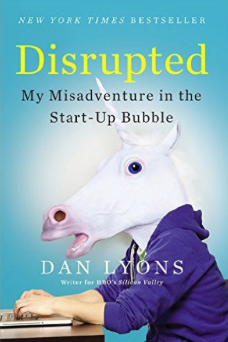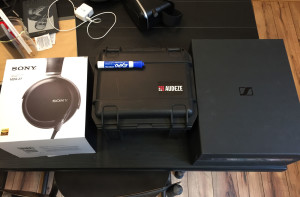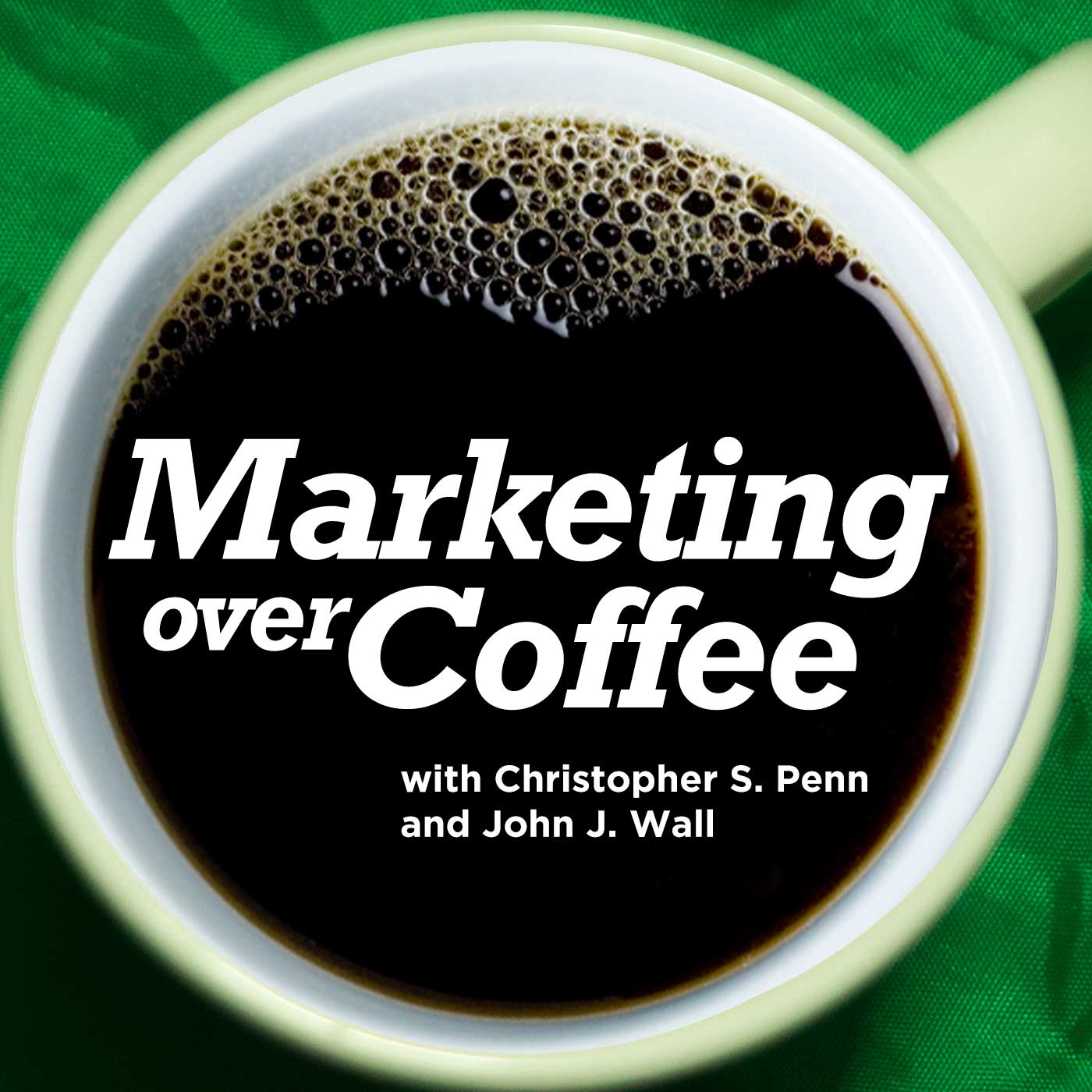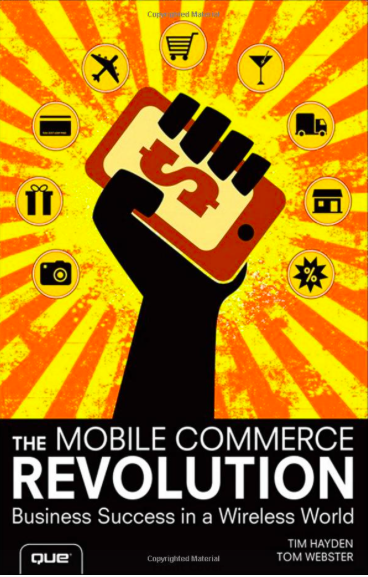Dan Lyons’ scathing tell all “Disrupted: My Misadventure in the Start-Up Bubble” came out last month and I’d been eagerly awaiting the book as have many in the Boston and marketing software communities. He tells of his time at Hubspot, the Cambridge-based startup that went all the way to IPO and took the lead as champion of Inbound Marketing.
I’m always looking for interesting books to profile for Marketing Over Coffee but decided to pass on Disrupted. I thought it would be just a bunch of stories of startup lifestyle, parties with career limiting consequences, bad ideas and burn rate. The goal of the podcast is to educate and entertain. I try to avoid the negative slants of industry gossip or making fun of failed marketing campaigns. We do cover that stuff, but failing a lot, often spectacularly, is what happens at startups. Most of them fail – Hubspot is one of the exceptions. I’ve been at more than one place that was a lot crazier, that also crashed and burned.
I used my monthly Audible credit to get the book (I said I would refuse to buy it, so this was me going half-truth on that so I didn’t have to wait for a library copy to finally get around to me) and tore through it. Even if you are not going to read all the “Inside Baseball” that follows, the TL;DR is: This is not just a book comparing a startup to a cult, it presents a lot of big issues: the nature of the workplace, the place in our society for the rapidly growing over 40 demographic, our financial system and how it perpetuates disparity of wealth, the death of journalism, and the trade off between privacy and being a member of the online world. If you are interested in any of these topics you should get this book.
I’d also recommend the audiobook because many of the key plot points are meetings and discussions between Lyons and his fellow employees. Hearing him do the voices paints a more vivid picture of when somebody is giving a crazy answer, laying out some wild idea, or the subtle sarcasm in his answers that you would miss if read off the page.
Ok, so if you’ve made it this far I’m presuming you’re in and want all the details. Even though I decided to pass on this for the podcast, so many things about this book were banging around in my mind because I’ve lived through a bunch of these situations, everything from bringing a company from near zero to a successful acquisition, to having my “position eliminated”, i.e. “we promised higher ups that hiring you would create explosive growth this quarter and it didn’t and now I have to fire you so that it’s not me.” Even after many years you can’t help but look back on the turning points and think about how it could have been better or worse. I’m writing this to get it all out of my head, but at the same time my wife listened to much of the book and had questions about how and why this could happen, so if you’re interested in this, my therapy might also give you some insight.
Rules and a boatload of disclaimers: This post is for people who have read the book. There’s been a lot of social media rambling from people who haven’t. I’ll run this by a friend to make sure it can be read if you haven’t read the book, but if you haven’t and you make a stupid comment I’ll probably delete it.
Mike Volpe was brave enough to have Hubspot take a chance as an early sponsor of Marketing Over Coffee, years before the laggards got hooked on Serial. Chris Penn and I were also guests when Hubspot did a video show and we met many team members during our visit there. I met Dan Lyons at his book signing for “Options – The Secret Life of Steve Jobs“, part of his Fake Steve Jobs writing, which is the funniest and most entertaining writing that has ever been done on the tech industry. It’s been 8 years since I read Options and I still laugh out loud when I think of the part where Hillary Clinton goes to meet the Tech Titans of Silicon Valley (pg. 140 in my copy). I’ve known Scott Kirsner for many years and have been to one of his events on Nantucket, he’s brave enough to try and figure out where he fits in the post-newspaper age and he’s painted as a gun for hire but he is the first choice if you have a question about what’s going on in the Boston tech scene.
And this is where you get your first taste of crazy. I’ve worked with all these people and I like them. When I first heard of Dan going to Hubspot I thought it was fantastic, I couldn’t wait to read what he was going to write with access to those resources and audience. Like all startups, it sounds like an exciting idea, and yet somehow it ended up with an FBI investigation.
Where does all this crazy come from? For any startup you are trying to do something never done before, and many may think that what you are trying is not possible, so that’s the crazy seed. The founders may be visionaries seeing the future, or f#$%ing lunatics. Taking money from venture capital investors (VCs) is like alcohol in an the old Bill Cosby standup routine: “Alcohol magnifies your personality”… “but what if you’re an a-hole?” (Sorry about the recursive mess of a Bill Cosby alcohol joke.)
Once you have VC you are pledging to rapid growth. Usually the founders have pitched this but have no real idea if/how it will happen, and the VC’s also live with the conflict of believing in the startup enough to invest in them, while also believing more of their investments will fail than succeed. Finally, the crazy tree is at full height when preparing an IPO, a massive amount of work that does not really have anything to do with directly serving customers (besides making sure you have the money to stay in business).
Dysfunction of demanding quarterly growth from what used to be an organic process – I could belabor this but it’s enough to say if you gather 9 women and think you are going to get a baby in one month it’s not going to be what you’re expecting, it’s going to be crazy stuff.
When I heard about the book I immediately thought “wow, this is going to get messy” and yee-haw, another successful prognostication for me. I was conflicted because I hated the idea of someone taking a shot at a successful Boston startup, yet knew I would laugh at anything Lyons wrote. I said I wanted nothing to do with it, while my curiosity was killing me. Yes, there are the tales of drunken hook-ups, standing desks, crazy outings but at the heart of it is “What happens when your career has been blown to bits and you’re thrown into a startup.”
He writes about his first day, showing up nervous and ready for amazing things. Instead of getting welcomed at the door, nobody knows he was showing up today. It takes more than a day to work things out.
When I started it I’m laughing and already hooked at this point. Rewind about a year – I’m at the Hubspot receptionist desk, excited out of my mind, I’ve set up a time to talk with Dan Lyons, the funniest tech writer ever, and going to guest on their new podcast. I’m also getting an interview with Mike Volpe for Marketing Over Coffee, it’s been a couple of years since he was last on and we’re due for an update on what’s going on with Inbound Marketing. I’m stuck at the receptionist desk, the woman there has no idea who Dan Lyons is. After about a half hour she finds out that he’s no longer with the company. The interviews are still on though and somebody that works with Mike sets me up with a desk so I can get some stuff done as things come together. I’m on the top floor in a space that has just been worked on so most of the desks in the open layout are empty. There’s a big mural of a dinosaur walking through the city and I laugh for a second thinking about myself as approaching dinosaur territory. About 20 minutes later my cube neighbor shows up, it’s Brian Halligan. We’ve met a couple times before so we say hello and catch up, he makes a joke about being the dinosaur in the building and that’s why he’s under the mural and I have some line about it being good to have at least one person in the building that has experience running a business. The interviews go well, everyone says Lyons went over to the HBO show which makes perfect sense to me, so I’m disappointed that my imaginary lunch with Dan never happened and figure that’s the last I’ll hear about it.
Nope. I can’t remember the order, but I heard that the guys were gone and then I heard about the book. I even connected the dots and said “I bet they were trying to get the book!” I wish I could remember who I talked to about that to confirm prognostication #2 but it’s not that important. Then there was the press release, talk of an FBI investigation, but really no new info until the book came out. On to some points to clarify:
All startups tend to be more like cults than jobs. The founders are giving up a normal life of paycheck and health insurance to do something crazy. You can have angels that put money in and work for free to get things off the ground. Teams taking on this insane level of risk create bonds far beyond anything that happens in a standard 9-5 shop.
Comparing any startup to a Fortune 100 company will make it look poorly managed. At a well managed business your list for the day might have 8 things on it. The employee can usually get 6-10 things done. If the employee can’t get the 6-10 they hire another person, if they are constantly sitting around doing nothing they get more work to do or are laid off.
At a startup your list for the day has 25 things on it. 12 of them really needed to be done last week, 10 of them need to be done today. There’s no time travel though, people still chip the same 6-10 things off the list per day. As a result there are always projects behind or abandoned, this is how things like the receptionist not knowing you happen.
This high risk, low management environment is part of why startups can be innovative. Clayton Christensen has done brilliant work explaining why “well managed” ends up meaning “unable to innovate” and “soon to be crushed by a more agile competitor.” The Innovator’s Dilemma is one of my favorite books (and yes, I realize that having a favorite business book, by definition, makes me old).
Founders not being hands on or in the office every day is not surprising. The problem with the startup is that it is both a sprint and a marathon. I once had to work about 30 hours straight when we had updated our software and needed to get a working demo machine set up to bring to an event the next day. This was just before “The Cloud” arrived so any major project involved building servers. Installing an Oracle database at 2am is a pain, but on the upside there were long breaks in the install process so I could go ride one of the company scooters around in gigantic empty parking lot when I got sick of being alone inside.
Of course you can only do this kind of insanity in short bursts, after 2 or 3 years straight you would lose your mind or drop dead. If the company starts to have some success they get enough resources for more employees. At this point a cultural shift begins from crazy entrepreneurs to more normal employees. As everything gets bigger you are able to find employees who are specialists and if you are doing it right, they are smarter in their area of expertise than the previous round of people. To give you an example, Volpe came on as marketer at something like employee #5. I don’t know exactly where work was divided but odds are he was doing content, running the website, email, advertising… everything. Fast forward 6 or 7 years and now the marketing team is bigger than the whole company was when he started and there’s a whole team doing what he used to do by himself.
Now the founders want to do something different because they’ve been running like maniacs for years so they focus down to the things they want to work on and delegate the rest. And, if they’ve done it right the new hires don’t want the founders getting involved that much anyway, they have more specialized knowledge and are doing the day to day so they have no interest in a founder as Seagull Manager (flying over now and then to crap on everything). In “normal” jobs the manager is working with his employees managing, in startups it’s not uncommon to have founders who just have an office they sit in and work on crazy projects, or they are always on the road doing speaking gigs, or actively working on their next startup project. They are not going to leave because there may be a huge payday in the near future, but they are in no way your classic employee. This is where you see a lot of great startup drama when investors keep coming in and start to gain board seats, and may put the crosshairs on a founder that’s not delivering the growth they originally promised the VCs.
Employee vs. Entrepreneur vs. Internet Celebrity – I’ve always said that building a startup is like creating a recipe for a killer dish by randomly adding ingredients. You may have everything in order for that chocolate chip cookie but if you’re using salt instead of sugar you’re stuck with something inedible. Each employee is a new ingredient and even though each ingredient on its own may be a favorite, you’re not going to sell a ton of Meatball Sundaes.
As positions and culture are built on the fly there’s a lot of opportunity for confusion. Anyone from a normal job might go into a startup expecting a manager that explains what needs to be done, spends time training them, and has clear goals as to what the employee needs to do to be successful. Far more likely, when the employee is hired the entrepreneur is thinking “Whew, that was a ton of work there, I’m glad I’ve got an expert so I never have to do that again.” Now both parties are expecting the other to figure it out. I’m not saying this is right but from what I’ve seen, the burden to clearly define things and get them done falls to the employee, not the supervisor. Yes, it would be great if there was a mentoring and leadership culture but often there isn’t.
I’ve also seen companies hiring people that have their own following, thinking that the employee’s celebrity is a magic wand that’s going to bring thousands of fans and prospects. In reality, internet celebrity is like building a waterfall, it’s powerful and impressive but you don’t drag it around with you. If you’re famous for posting cat pictures and you go work for a plumbing company none of you cat fans is going to give a damn. Or if they do it’s going to be one confused visit to the home page and then gone for eternity.
And of course if you hire a guy who got famous making wise remarks, don’t be surprised when his co-workers get pissed at him for making wise remarks.
Tough questions, no answers. This was the most interesting part of the book for me, it takes on some big questions that we don’t really have good answers for. Disrupted makes light of young people with little experience being hired but at least Hubspot is hiring many college graduate employees at a time when skilled entry level jobs are not plentiful with college graduates facing unemployment rates around 30%. Most startups I know don’t bother with intern programs or first time employees, the infrastructure to train people is not there, you’re expected to show up knowing what to do and how to do it. It also touches on ageism. The simple out is to call it discrimination – old people are not wanted anymore, but it’s more complicated. Old people are not stupid enough to take crappy jobs for 30k. Old people see the disconnect between “We are a team, not a family” and “building a company we love.” And on the other side there are old people not interested in learning new software, or being more than happy to exploit a situation where a company is moving to fast to really see how much work is getting done. This is not a Hubspot thing, this is everywhere.
There’s the hot issue of inequality of wealth, with a small group making a ton of money while everyone else gets shuffled off to the next thing. And a nod to privacy, that anybody can spy on us, through any of the online services we use, but nobody is going to back out of them. If we want to be at the party, giving your privacy up is the ticket at the door. We’re not using a product, we are the product.
What really happened? We’ll probably never find out, the problem with publicly traded cloud companies is that, at their core, they are responsible for data integrity so there’s no upside to them ever talking about any kind of security breach unless they have to. The reports of a possible FBI investigation would make me think someone ratted to their board of directors. The thought of it being someone on the outside for justice or PR, or someone inside as some kind of coup both seem absurd to me, but I’ve got no other theories that make sense.
There was an official response, and I have to give big time kudos to the fake cover they did, they get the symbolism award for changing the unicorn head to racehorse horse/horse’s ass.
Hubspot Customers don’t care, they want to make more money, they want good tools. They could not give a damn about some internal executive politics, especially if the software is making them money. You could look at this thing as the new Dean Martin Tech Celebrity Roast. If Dean Martin was still alive, and people still did roasts, and you were young enough to get this joke…. never mind.
I don’t think this book is going to slow Hubspot down, if people are as engaged with this book as I was it will sell lot of copies. The bad news there is that the books I love tend not to be best sellers. As I wrap up I’m the guy at the poker table looking around for the idiot who’s losing money on this deal and realizing it’s me wasting my time talking about it when I could be working. So, after all that, I’m glad this is out of my head so I can get back to making my own mistakes. Thanks for listening.

















